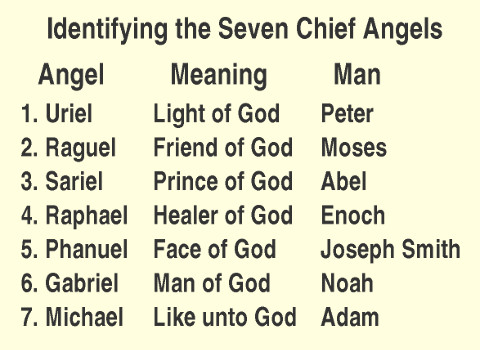
by John P. Pratt
16 Jan 2020, 13 Temple (SR), End Tabernacles (UH)
©2020 by John P. Pratt. All rights Reserved.
|
1. 7 Angels, not 7 Men 2. Seven Chief Angels 2.1 Michael: Adam 2.2 Sariel: Abel 2.3 Phanuel: Joseph Smith 2.4 Uriel: Enoch 2.5 Gabriel: Noah 2.6 Raphael: Enoch 2.7 Raguel: Moses 3. Conclusion Notes |
In my previous articles about constellations, it was shown that not only do all 48 of the original set silently tell the story of Jesus Christ in twelve roles (Psa. 19:1-3),[1] but also when the Twins are separated into two, then a 7x7 table of 49 constellations indicates that there is a set of 7 constellations associated with each of the seven chief angels.[2]
 |
The Book of Enoch states that there are 364 stars which each represent a servant of God, but it also seems that entire constellations could represent men also. The Lord has promised to give us a pattern in all things, so that we may know the truth (D&C 52:14). One pattern is the 7x7 table of constellations, but what does it mean?
Now in the light of more understanding of multiple mortal probations,[3] also called the Doctrine of the Eternal Round, this understanding has blossomed into a much fuller understanding of the symbolism of the constellations. Instead of seven constellations being associated with each of only seven mortal men, it now appears that each of the seven chief angels lived multiple times on earth in order to help mankind to progress along their individuals paths to salvation. Thus, each column of seven constellations can represent several lives of one of the angels, perhaps having lived once as a priesthood leader and another time as a prophet.
This article is the first of a series which attempts to identify mortal men with the constellations. This first one briefly reviews what has been known up until now about the constellations which were revealed to the Prophet Enoch, and then proceeds to identify which constellation represents the one lifetime which until now was assumed to be the only lifetime associated with that angel as shown in Table 1. Subsequent articles will attempt to identify other mortal lives of these seven angels.
Let us first review and update what has been published in my work prior to this time. The key to all of this star and constellation work has been the Book of Enoch, which was accepted and quoted over one hundred times by the Savior as authentic and teaching truth.[4] It teaches that the constellations were revealed to Enoch by the angel Uriel.
There was an original set of 48 constellations revealed which can be divided into twelve sets of four. There are twelve constellations called the "zodiac" through which the sun, moon and planets all appears to travel. They represent twelve roles which the Savior fulfills, each accompanied by three explanatory constellations. A few minor changes have been made in their arrangement over the years, with the latest update being shown in Figure 1. They are numbered from right to left so that the top row of zodiac constellations are shown as they appear in the heavens. The numbers are in that order because the zodiac figures are like the hour numbers on a huge clock, where the Maiden (Virgo) is like 1 o'clock and the Lion (Leo) is like 12 o'clock.
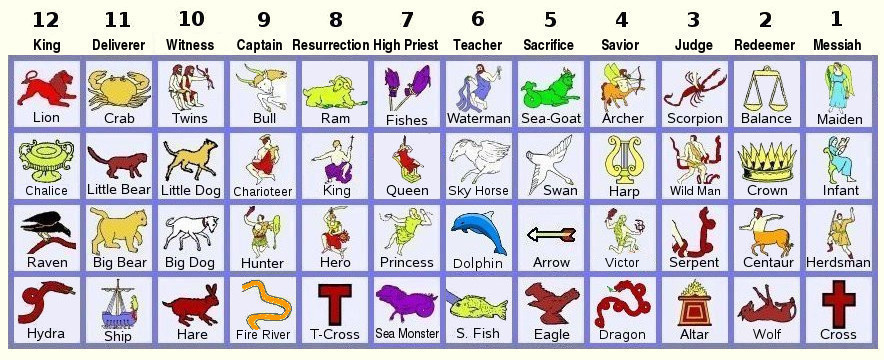 |
When the Twins (top of column 10 in Figure 1) are separated as two different constellations, then that total of 49 constellations may be represented as a 7x7 table. That is shown in Figure 2, with the Twins becoming the Warrior (Castor) and the Champion (Pollux). That table is actually a map of the entire sky as seen from the northern hemisphere in the days of Enoch. For an observer looking south, the directions of east and west and north and south are indicated.
Former versions of this table had identified men who had lived their mortal life as each of the angels, as shown in Table 1.[5] Figure 2 shows an updated form of the previously published table.[6] Clicking on the table displays the usual astronomical names. Earlier versions had the men's names listed at the heads of the columns, not the names of the angels as shown in this version. The two were thought to be synonymous and that the human names would be more recognizable. Now it is understood that the human name only represents one of the lives of that angel, so the angel names head the columns. The rows represent different levels of spirituality as labeled on the left.
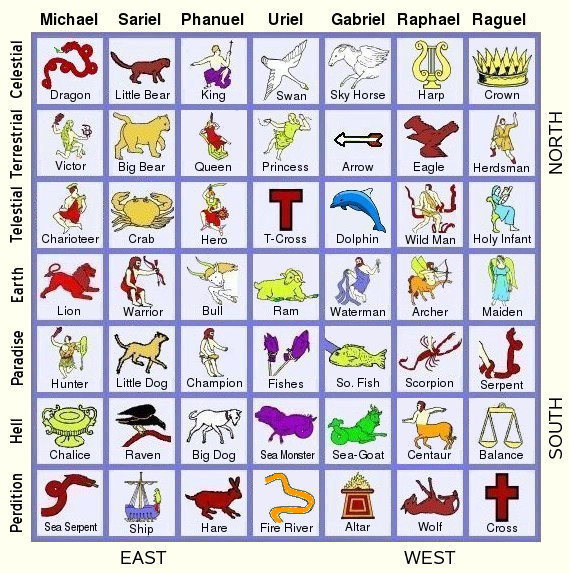 |
The first order of business is now to identify which mortal life of the seven angels listed in Table 1 corresponded to which constellation in his column. In other words, until now, the first column headed "Michael" in Figure 3, formerly was headed with the name "Adam", because it was assumed that all constellations in that column were thought to pertain to Adam. Now it is believed that only one of those constellations represents Adam. Which one?
The rule which has been adopted to propose a solution to this puzzle is that the constellation figure must depict something about the angel during that mortal lifetime. Using that tool, let us now attempt to discover which constellation belongs to each of those seven men listed in Table 1. When "star days" are mentioned as the birth or death dates of these men, they refer to dates on the Star Calendar. They are listed chronologically in my Religious Chronology, where references to how they were derived are provided.
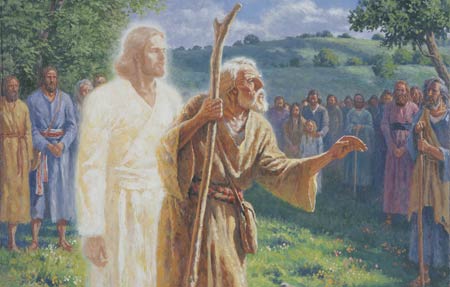 |
But according to the proposed rule, the Hunter cannot represent Adam during his mortal life because there was no river of fire mentioned in Genesis before Adam's death. What did occur in Adam's mortal life, which could be depicted by one of the constellations in Michael's column?
Shortly before his death, at a grand council with his posterity, Adam was called "the Prince" (D&C 107:54). He has also been called "the prince of all" in other modern revelation (D&C 27:11). That ties directly to the stars in the Lion (Leo) for two reasons. First, the brightest star therein is "Regulus" which means "the Prince". It is the most important of the four "royal stars", which are approximately equally spaced on the ecliptic circle (apparent annual path of the sun through the stars). Secondly, the whole constellation symbolizes a king, namely the "king of beasts". It was Judah's birth constellation, representing his kingly line. Thus, it here proposed that the Lion symbolizes the mortal life of Adam.
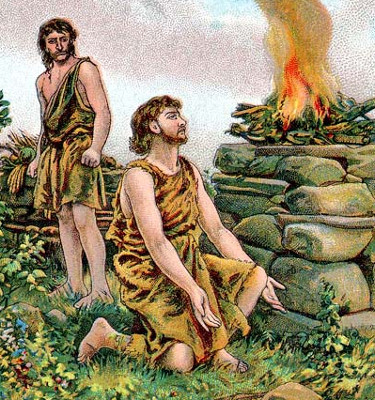 |
One clue as to which constellation should be Abel's is that the upper constellations are for prophets and the lower ones for those who fight or convert those who are evil. The two best candidates seem to be either one of the Twins or the Little Dog, who is like a twin to the Big Dog. Abel could be represented by a twin for two reasons. First, he may have actually been the twin brother of Cain because in Genesis it states that Eve conceived (once) and then bore two sons, Cain and Abel (Gen. 4:1-2). That may sound extreme to base being twins on the word "conceive" being absent for the birth of Abel, but that is exactly how the fact that Dinah was Zebulon's twin sister was hidden (Gen. 30:19-21). Secondly, Abel was like a twin because after he was slain, he was replaced by Seth who took his place, rather like a twin.
When this problem was pondered of whether Abel was a twin person or twin dog, the solution came from the Book of Enoch itself. There in one of the prophecies of the history of the world, the young bull representing Abel is given the color of red (the "red heifer" see Enoch 84:4, Num. 19:2). The color of the Twins' robes are red for the Warrior (Castor) and White for the Champion (Pollux). And sure enough, the Twin dressed in red is in Abel's (Sariel's) column. Therefore, it is proposed that Abel's constellation is that of the Western Twin, the Warrior.
That name "Warrior" comes from the myths about Castor rather than from the scriptures, which say very little about Abel. One final nice touch is that if Abel is the Warrior, then his constellation is adjacent to his father Adam's, the Lion (which is also red), in the table.
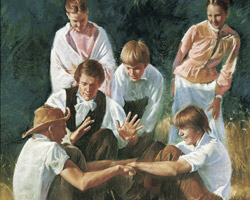 |
All four of those constellations are in Phanuel's column, and all were formerly thought to represent Joseph Smith! Now it is understood that all four represent a separate mortal probation of Phanuel. Joseph Smith is only allowed one constellation! Which one represents what he actually did during his life? That quickly narrows it down to one, because he did not finish slaying the Medusa (false religion) during his life time, nor did he as the Big Dog hunt down the wicked, adulterous Hare (Lepus), nor was he associated with a bull.
Joseph Smith was, however, well-known for being a champion wrestler, easily beating two different county champions in Missouri. In fact one of the accounts is remarkably similar to the myth of Polydeuces saving the crew of the ship Argo by beating the "world's greatest bully".[7] Thus, it is here proposed that the constellation of the Champion, the eastern Twin, represents the Prophet Joseph Smith.
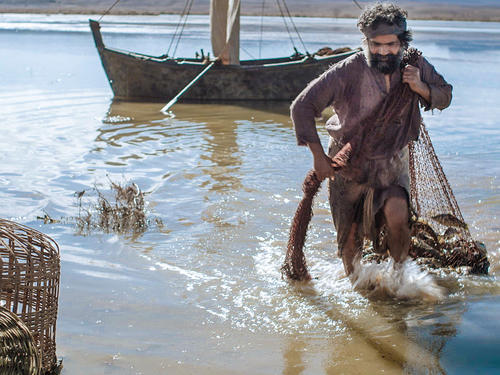 |
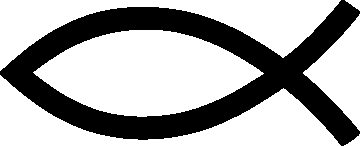 |
Because being a fisherman described Peter so well during life, it is proposed that the Fishes is the constellation for Peter. There is another reason for this choice. The rows also have significance. The top row, where the Swan resides, is for the men who were the most "celestial" during their mortal lives. As will be discussed in a future article, these slots are apparently reserved for the mortality of these angels as the great Old Testament prophets.
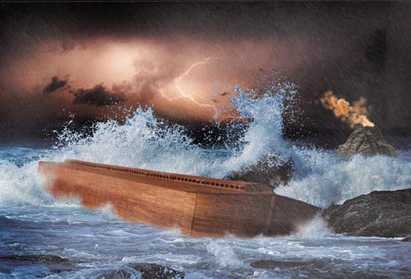 |
It might seem that the ship Argo (Argo Navis) would be the logical choice for Noah, but that ship is down in perdition filled with the damned who are seeking a better resurrection. Moreover, it is in Abel's column because that is its location in the sky, whereas it is the angel Gabriel who is known to have lived as Noah (TPJS p. 157). It just doesn't fit.
This is another case where in the past, several constellations in this column have been identified with the prophet Enoch. He was called a "wild man" (Moses 6:39) which suggests the Wild Man constellation (aka Serpent Bearer. Ophiuchus), being a man who is wrestling a large snake while squashing a scorpion! Also Enoch's royal star Antares is both in the foot of the Healer and in the heart of the Scorpion.
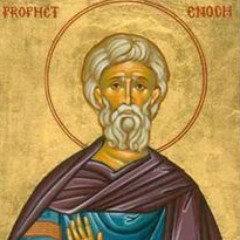 |
The best choice is apparently the Wild Man because he was known in life as a "wild man" and his royal star is in that constellation. The Lyre is a good alternate choice because it could represent his translation (instead of death). That upper row is reserved for prophets, but Enoch qualifies for that too.
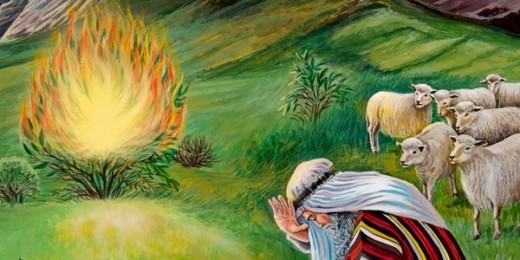 |
One of the constellations in that column is the Southern Cross, called simply "Cross" in my work, with which Moses also had an experience with the brazen serpent. That could qualify it as a second choice. The constellations on the bottom row are, however, mostly evil or represent working those who are evil, so that constellation is not likely to be correct for Moses. The Herdsman seems like a perfect fit.
These results for all seven angels are summarized in Figure 3, where each angel's name for one mortal probation is identified in red boldface type, as proposed in this section.
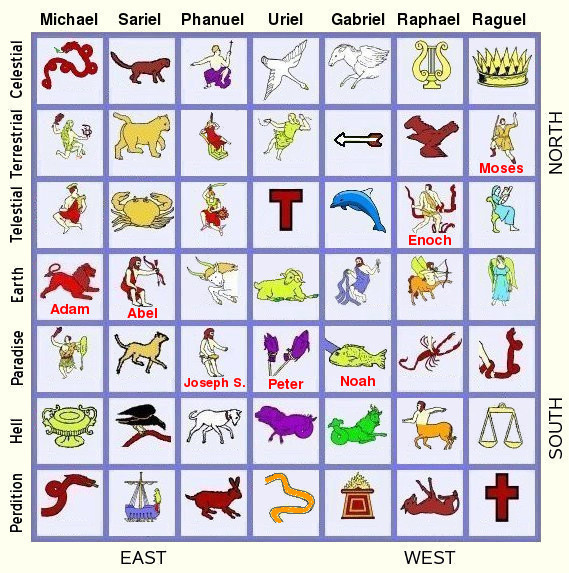 |
Formerly, the 7x7 table of original constellations was thought to represent events in the lives of the seven chief angels, who each were assumed to have lived only one mortal life. Now the emerging doctrine of multiple mortalities has opened the possibility that the each of those seven angels might have lived several lives, perhaps once as a dispensation head, once as a prophet, and once as a patriarch.
This article is the first of a series which will attempt to identify several mortal lives which may have been lived by each of these seven angels. This first article proposes one constellation to represent the life of the man who, until now, was thought to be the only mortal life of each angel.
The rule proposed to be used to determine the correct constellation is that the figure must represent something for which the man was known in mortality, perhaps being how he died.
The results were that the constellation were proposed: Adam is the Lion (Leo), Abel the Warrior (Castor of Gemini Twins), Joseph Smith the Champion (Pollux of Gemini Twins), Peter the Fishes (Pisces), Noah the Southern Fish (Piscis Austrinis), Enoch the Wild Man (Ophiuchus), and Moses the Herdsman (Bootes).
Future articles will attempt to identify several more constellations representing other mortal lives of these angels who are worthy servants of God.